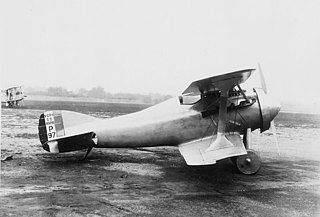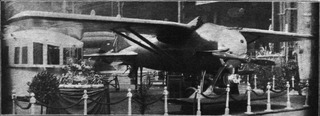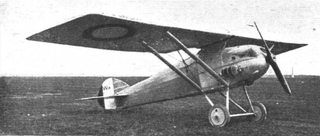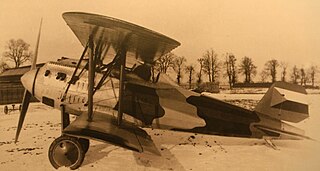
The Boeing Model 15 was a United States single-seat open-cockpit biplane fighter aircraft of the 1920s, manufactured by the Boeing company. The Model 15 saw service with the United States Army Air Service and with the United States Navy as a carrier-based fighter.

The Verville VCP was an American single-engined biplane fighter aircraft of the 1920s. A single example of the VCP-1 was built by the United States Army Air Service's Engineering Division, which was later rebuilt into a successful racing aircraft, while a second, modified fighter was built as the PW-1.

The Fokker D.XII was a Dutch single seat, single engine fighter aircraft designed to an American specification which called for the use of a Curtiss D-12 engine, designated PW-7. Despite considerable efforts to improve the airframe, Fokker failed to win the USAAS competition.

The Nieuport-Delage NiD 37 was a single-engine, single-seat monoplane fighter aircraft and racer designed and built in France in the early 1920s. It had a small foreplane to bring the centre of pressure forward. Heavy, slower than expected and with turbo-supercharger problems, development ended without any entering service.

The Nieuport-Delage NiD 48 was a French single-engine parasol wing light fighter aircraft, designed and built in the 1920s. Its performance was not markedly better than that of the much heavier Nieuport-Delage NiD 62 then going into production, so only two were flown.
The Wibault Wib 1, Wib C1 or, later, Wib 1 C1 was a French World War I single seat, single engine fighter aircraft prototype. Flown near the end of the war, it was not selected for production.

The Wibault 3 or Wibault Wib 3 C.1 was a French parasol wing prototype fighter aircraft from the 1920s, designed for high altitude operations. Its development was abandoned after repeated materials failure in its supercharger.

The Wibault 8 or Wib 8 Simoun (Simoon) was a tandem seat, parasol wing fighter aircraft designed and built in France to a 1925 specification which was later withdrawn; only one Wib 8 was completed.

The Wibault 13C.1 Trombe (Whirlwind), later known as the Wib 130C.1 Trombe was a single seat, parasol wing lightweight fighter aircraft designed and built in France in the 1920s. It was developed into the more powerful Wib 170C.1 Tornade (Tornado) but government interest in lightweight fighters soon waned.

The Letov Š-7 was a single-seat, single-engine biplane fighter aircraft designed and built in Czechoslovakia in the early 1920s. It was designed for a single-seat fighter competition but did not reach production.
The Letov Š-13 was a single-seat, single-engine fighter aircraft designed and built in Czechoslovakia in the early 1920s. A biplane, it had aerodynamically thick wings which were originally cantilever structures, though interplane struts were later added. Only one was produced.

The Letov Š-14 was a single-seat, single-engine aircraft, designed and built in Czechoslovakia in the early 1920s. Originally intended as a biplane fighter, it was later modified into a monoplane and entered as a contestant in a speed competition.
The Hanriot HD.5 was a French two-seat fighter aircraft prototype, built towards the end of World War I. A single-engine biplane with an unusually narrow gap between the upper and lower wings, it did not enter production.

The Hanriot HD.15 was a French two seat fighter aircraft fitted with a supercharger for good high altitude performance, built in the 1920s. Three were ordered by Japan but lost at sea during delivery.
The Hanriot HD.20 was a French single seat shipboard fighter aircraft prototype completed in 1923. Only one was built.

The Hanriot H.26 was a French single seat fighter aircraft prototype completed in 1923. Only one was built.
The Descamps 27 C1 was a single seat biplane fighter aircraft, built in France in 1919. It was unusual in having a forward swept lower wing. After competitive trials, the Nieuport 29 was chosen for production, so only one Descamps was built.

The de Marçay 2 C1 was a single seat biplane fighter designed in France and first flown in 1919. It did not go into production.
The de Marçay 4 was a single seat monoplane fighter built in France in 1923 for a government competition. It did not receive a production contract.
The Caspar CJ 14 was a German fighter aircraft prototype built in the 1920s.














